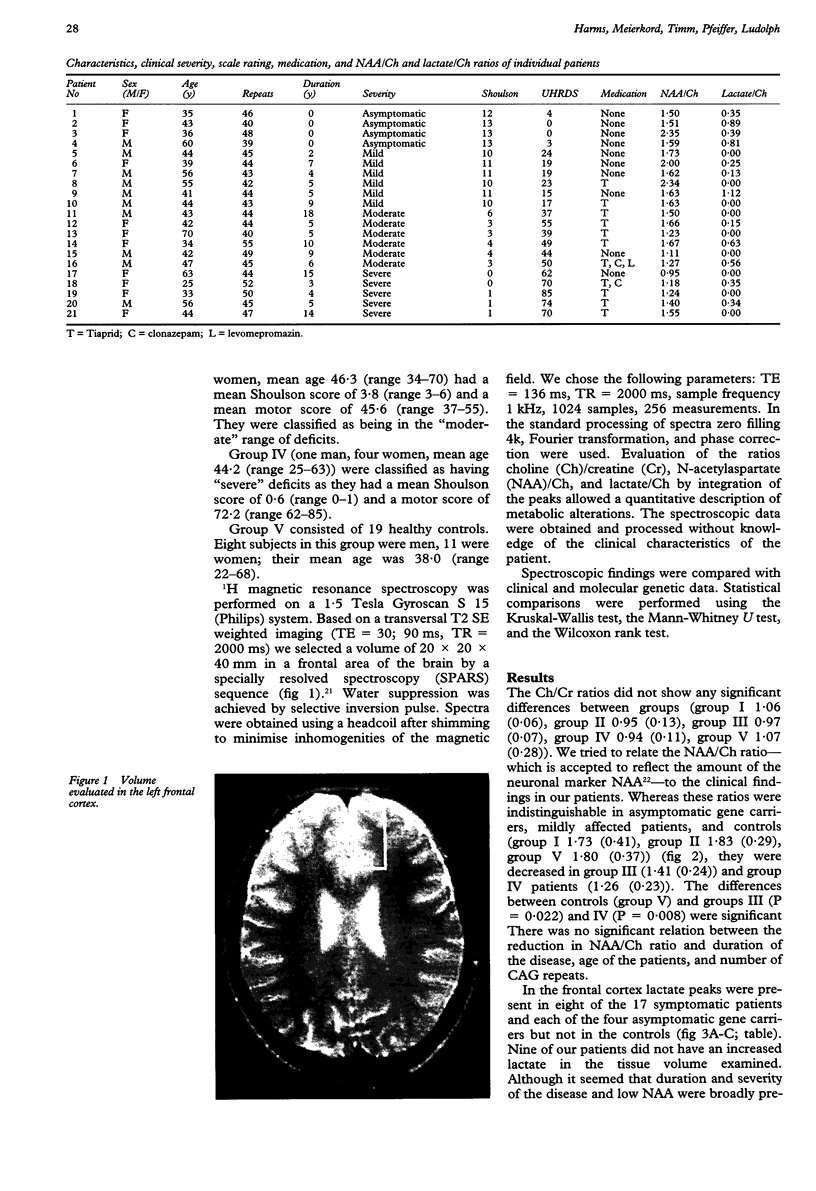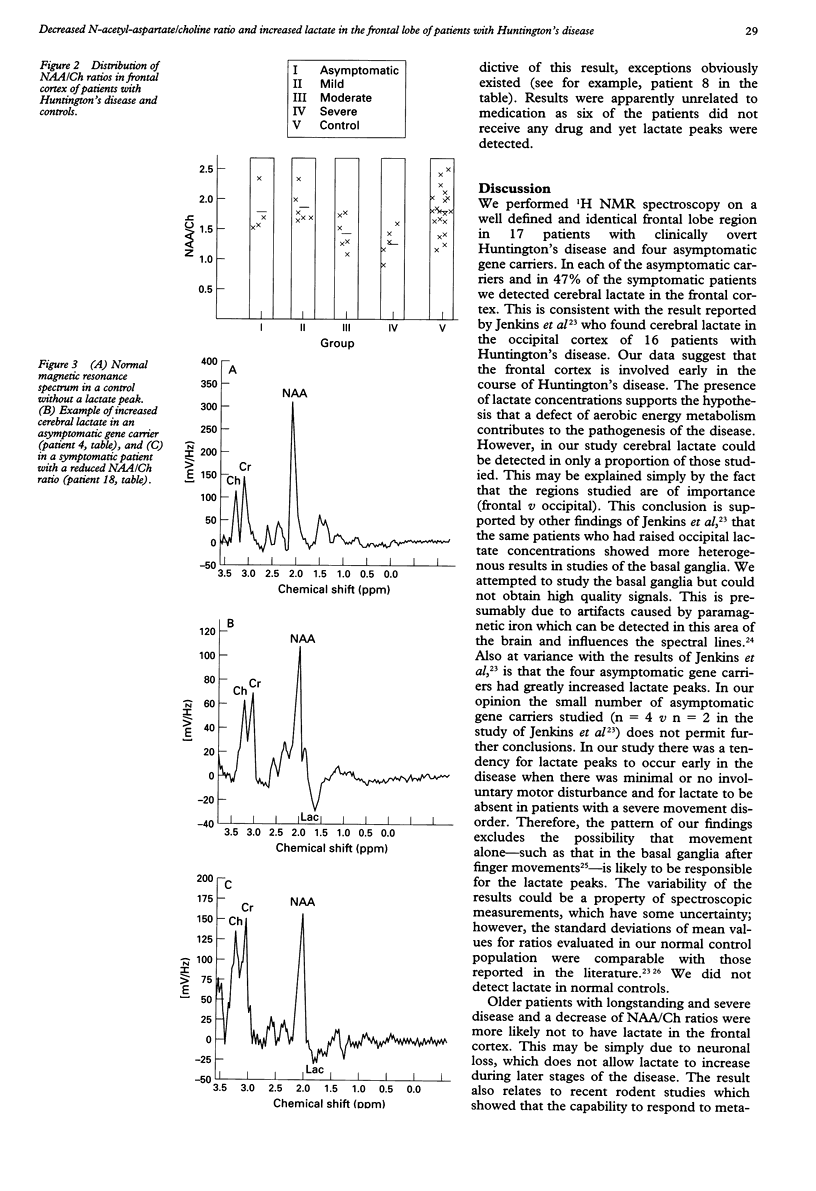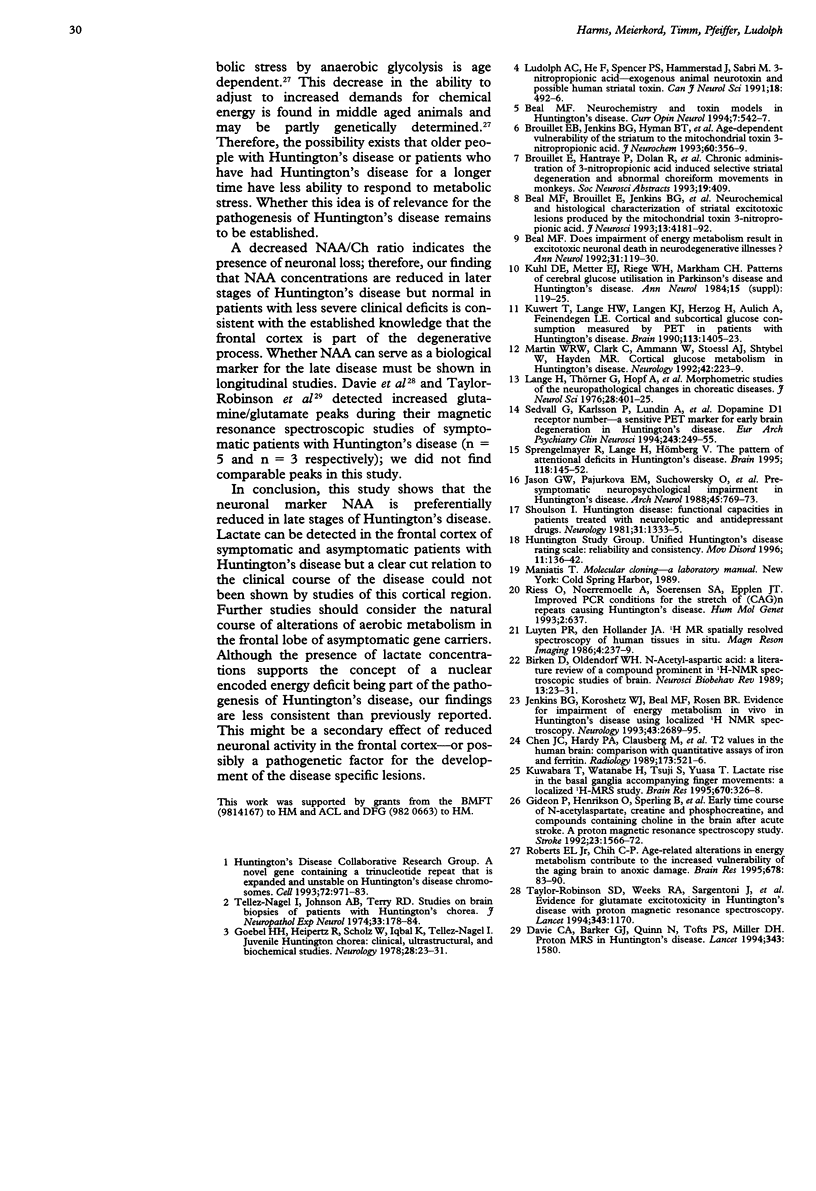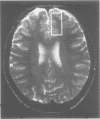Abstract
BACKGROUND: Both the effect of the mutation and the pathogenesis of Huntington's disease are unknown and a lack of biological markers for the natural history of the disease impedes the evaluation of novel therapeutic approaches. METHODS: Proton magnetic resonance spectroscopy was carried out on a frontal region of the cortex in 17 patients with clinically overt Huntington's disease and four asymptomatic gene carriers. RESULTS: Eight of 17 (47%) clinically affected patients with Huntington's disease and each of the asymptomatic carriers had lactate peaks in the frontal cortex which were not present in controls. The N-acetyl-aspartate/choline (NAA/Ch) ratio was significantly reduced in the symptomatic patients indicating the presence of neuronal loss. The reduction was related to the clinical severity of the disease and was absent in the asymptomatic carriers. CONCLUSION: The finding of lactate peaks supports the hypothesis that disturbed cerebral energy metabolism contributes to the pathogenesis of Huntington's disease.
Full text
PDF



Images in this article
Selected References
These references are in PubMed. This may not be the complete list of references from this article.
- Beal M. F., Brouillet E., Jenkins B. G., Ferrante R. J., Kowall N. W., Miller J. M., Storey E., Srivastava R., Rosen B. R., Hyman B. T. Neurochemical and histologic characterization of striatal excitotoxic lesions produced by the mitochondrial toxin 3-nitropropionic acid. J Neurosci. 1993 Oct;13(10):4181–4192. doi: 10.1523/JNEUROSCI.13-10-04181.1993. [DOI] [PMC free article] [PubMed] [Google Scholar]
- Beal M. F. Does impairment of energy metabolism result in excitotoxic neuronal death in neurodegenerative illnesses? Ann Neurol. 1992 Feb;31(2):119–130. doi: 10.1002/ana.410310202. [DOI] [PubMed] [Google Scholar]
- Beal M. F. Neurochemistry and toxin models in Huntington's disease. Curr Opin Neurol. 1994 Dec;7(6):542–547. doi: 10.1097/00019052-199412000-00012. [DOI] [PubMed] [Google Scholar]
- Birken D. L., Oldendorf W. H. N-acetyl-L-aspartic acid: a literature review of a compound prominent in 1H-NMR spectroscopic studies of brain. Neurosci Biobehav Rev. 1989 Spring;13(1):23–31. doi: 10.1016/s0149-7634(89)80048-x. [DOI] [PubMed] [Google Scholar]
- Brouillet E., Jenkins B. G., Hyman B. T., Ferrante R. J., Kowall N. W., Srivastava R., Roy D. S., Rosen B. R., Beal M. F. Age-dependent vulnerability of the striatum to the mitochondrial toxin 3-nitropropionic acid. J Neurochem. 1993 Jan;60(1):356–359. doi: 10.1111/j.1471-4159.1993.tb05859.x. [DOI] [PubMed] [Google Scholar]
- Chen J. C., Hardy P. A., Clauberg M., Joshi J. G., Parravano J., Deck J. H., Henkelman R. M., Becker L. E., Kucharczyk W. T2 values in the human brain: comparison with quantitative assays of iron and ferritin. Radiology. 1989 Nov;173(2):521–526. doi: 10.1148/radiology.173.2.2798884. [DOI] [PubMed] [Google Scholar]
- Davie C. A., Barker G. J., Quinn N., Tofts P. S., Miller D. H. Proton MRS in Huntington's disease. Lancet. 1994 Jun 18;343(8912):1580–1580. doi: 10.1016/s0140-6736(94)92987-4. [DOI] [PubMed] [Google Scholar]
- Gideon P., Henriksen O., Sperling B., Christiansen P., Olsen T. S., Jørgensen H. S., Arlien-Søborg P. Early time course of N-acetylaspartate, creatine and phosphocreatine, and compounds containing choline in the brain after acute stroke. A proton magnetic resonance spectroscopy study. Stroke. 1992 Nov;23(11):1566–1572. doi: 10.1161/01.str.23.11.1566. [DOI] [PubMed] [Google Scholar]
- Goebel H. H., Heipertz R., Scholz W., Iqbal K., Tellez-Nagel I. Juvenile Huntington chorea: clinical, ultrastructural, and biochemical studies. Neurology. 1978 Jan;28(1):23–31. doi: 10.1212/wnl.28.1.23. [DOI] [PubMed] [Google Scholar]
- Haase A. T., Pagano J., Waksman B., Nathanson N. Detection of viral genes and their products in chronic neurological diseases. Ann Neurol. 1984 Feb;15(2):119–121. doi: 10.1002/ana.410150202. [DOI] [PMC free article] [PubMed] [Google Scholar]
- Jason G. W., Pajurkova E. M., Suchowersky O., Hewitt J., Hilbert C., Reed J., Hayden M. R. Presymptomatic neuropsychological impairment in Huntington's disease. Arch Neurol. 1988 Jul;45(7):769–773. doi: 10.1001/archneur.1988.00520310079021. [DOI] [PubMed] [Google Scholar]
- Jenkins B. G., Koroshetz W. J., Beal M. F., Rosen B. R. Evidence for impairment of energy metabolism in vivo in Huntington's disease using localized 1H NMR spectroscopy. Neurology. 1993 Dec;43(12):2689–2695. doi: 10.1212/wnl.43.12.2689. [DOI] [PubMed] [Google Scholar]
- Kuwabara T., Watanabe H., Tsuji S., Yuasa T. Lactate rise in the basal ganglia accompanying finger movements: a localized 1H-MRS study. Brain Res. 1995 Jan 30;670(2):326–328. doi: 10.1016/0006-8993(94)01353-j. [DOI] [PubMed] [Google Scholar]
- Kuwert T., Lange H. W., Langen K. J., Herzog H., Aulich A., Feinendegen L. E. Cortical and subcortical glucose consumption measured by PET in patients with Huntington's disease. Brain. 1990 Oct;113(Pt 5):1405–1423. doi: 10.1093/brain/113.5.1405. [DOI] [PubMed] [Google Scholar]
- Lange H., Thörner G., Hopf A., Schröder K. F. Morphometric studies of the neuropathological changes in choreatic diseases. J Neurol Sci. 1976 Aug;28(4):401–425. doi: 10.1016/0022-510x(76)90114-3. [DOI] [PubMed] [Google Scholar]
- Luyten P. R., den Hollander J. A. 1H MR spatially resolved spectroscopy of human tissues in situ. Magn Reson Imaging. 1986;4(3):237–239. doi: 10.1016/0730-725x(86)91063-5. [DOI] [PubMed] [Google Scholar]
- Martin W. R., Clark C., Ammann W., Stoessl A. J., Shtybel W., Hayden M. R. Cortical glucose metabolism in Huntington's disease. Neurology. 1992 Jan;42(1):223–229. doi: 10.1212/wnl.42.1.223. [DOI] [PubMed] [Google Scholar]
- Riess O., Noerremoelle A., Soerensen S. A., Epplen J. T. Improved PCR conditions for the stretch of (CAG)n repeats causing Huntington's disease. Hum Mol Genet. 1993 Jun;2(6):637–637. doi: 10.1093/hmg/2.6.637. [DOI] [PubMed] [Google Scholar]
- Roberts E. L., Jr, Chih C. P. Age-related alterations in energy metabolism contribute to the increased vulnerability of the aging brain to anoxic damage. Brain Res. 1995 Apr 24;678(1-2):83–90. doi: 10.1016/0006-8993(95)00168-p. [DOI] [PubMed] [Google Scholar]
- Sedvall G., Karlsson P., Lundin A., Anvret M., Suhara T., Halldin C., Farde L. Dopamine D1 receptor number--a sensitive PET marker for early brain degeneration in Huntington's disease. Eur Arch Psychiatry Clin Neurosci. 1994;243(5):249–255. doi: 10.1007/BF02191583. [DOI] [PubMed] [Google Scholar]
- Shoulson I. Huntington disease: functional capacities in patients treated with neuroleptic and antidepressant drugs. Neurology. 1981 Oct;31(10):1333–1335. doi: 10.1212/wnl.31.10.1333. [DOI] [PubMed] [Google Scholar]
- Sprengelmeyer R., Lange H., Hömberg V. The pattern of attentional deficits in Huntington's disease. Brain. 1995 Feb;118(Pt 1):145–152. doi: 10.1093/brain/118.1.145. [DOI] [PubMed] [Google Scholar]
- Taylor-Robinson S. D., Weeks R. A., Sargentoni J., Marcus C. D., Bryant D. J., Harding A. E., Brooks D. J. Evidence for glutamate excitotoxicity in Huntington's disease with proton magnetic resonance spectroscopy. Lancet. 1994 May 7;343(8906):1170–1170. doi: 10.1016/s0140-6736(94)90280-1. [DOI] [PubMed] [Google Scholar]



